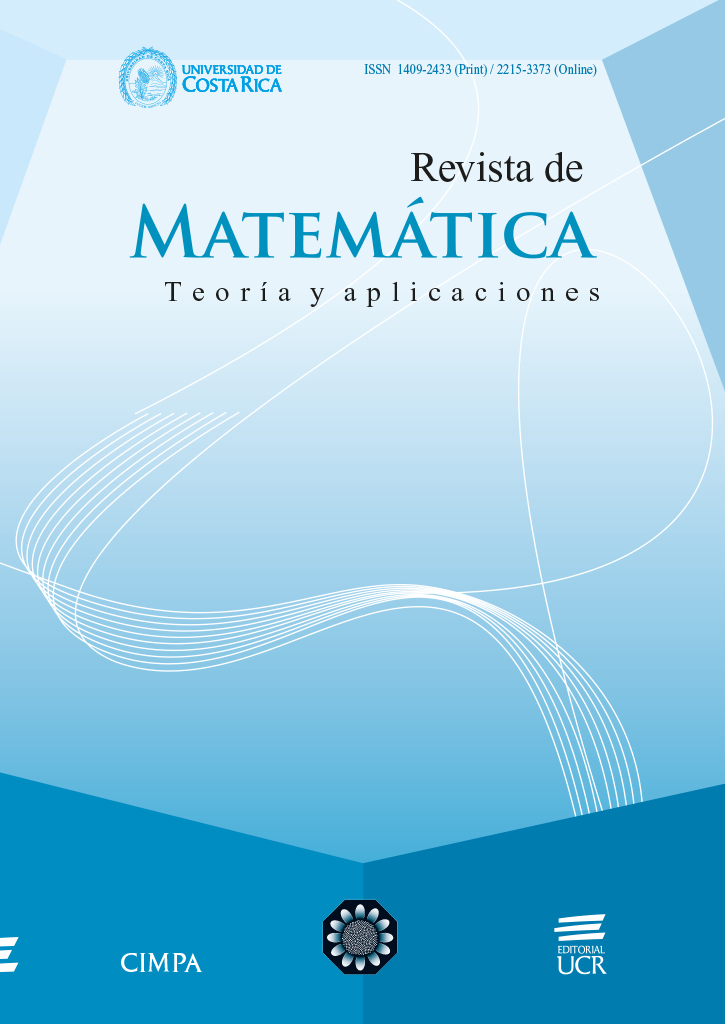Abstract
Antisocial behaviors such as consumption of addictive substances and eating disorders are modeled using a SIR model. We propose a function l(y(t)) that describes the relapse-recovery-recycling rate. l(y(t)) describes either strengthening or weakening of convictions of recovered individuals to relapse in antisocial behaviors. We show that a wide variety of functions can induce the existence of multiple equilibria points for R0 < 1 which is a catastrophic scenario for the susceptible population. Finally, conditions for avoiding a sudden and catastrophic jump in the number of individuals with antisocial behaviors are given.
References
ANRED, How many people have eating disorders?, Anorexia Nervosa and Related Eating Disorders, Inc. Retrieved on June, 2017 from https://www.anred.com/stats.html
D.A. Behrens, J.P. Caulkins, G. Tragler, J.L. Haunschmied, G. Feichtinger, A dynamic model of drug initiation: Implications for treatment and drug control, Mathematical Biosciences 159(1999), no. 1, 1–20. Doi: 10.1016/s0025-5564(99)00016-4
L.M.A. Bettencourt, A. Cintrón-Arias, D.I. Kaiser, C. Castillo-Chavez, The power of a good idea: Quantitative modeling of the spreads of ideas from epidemiological models, Physica A: Statistical Mechanics and its Applications, 364(2006), 513–536. Doi: 10.1016/j.physa.2005.08.083
C. Castillo-Chavez, B. Song, Dynamical models of tuberculosis and their applications, Mathematical Biosciences and Engineering 1(2004), no. 2,361–404. Doi: 10.3934/mbe.2004.1.361
C. Castillo-Garsow, G. Jordan-Salivia, A. Rodriguez-Herrera, Mathematical models for the dynamics of tobacco use, recovery and relapse, BU- 1505-M, Biometrics Unity Technical Reports, Cornell University 1997, 18 pages. https://hdl.handle.net/1813/32095
A. Cintrón-Arias, F. Sanchez, X. Wang, C. Castillo-Chavez, D.M. Gorman, P.J. Gruenewald, The role of nonlinear relapse on contagion amongst drinking communities, in: G. Chowell, J.M. Hyman, L.M.A. Bettencourt & C. Castillo-Chavez (Eds) Mathematical and Statistical Estimation Approaches in Epidemiology, Springer, Dordrecht, 2009, pp. 343–360. Doi: 10.1007/978-90-481-2313-114
O. Colon-Rentas, L. Gordon, L.D. Montejo, P. Reitsma, F.A. Sanchez, B. Song, The impacts of the sleeper effect and relapse on the dynamics of cigarette smoking among adolescents, Mathematical and Theoretical Biology Institute, report MTBI-03-04M, Arizona State University, 2006. https://qrlssp.asu.edu/2006-4
N.M. Crisosto, C.M. Kribs-Zaleta, C. Castillo-Chávez, S. Wirkus, Community resilience in collaborative learning, Discrete and Continuous Dynamical Systems Series B, 14(2010), no. 1, 17–40. Doi: 10.3934/dcdsb.2010.14.17
J.L. Dillon, N. Baeza, M.C. Ruales, B. Song, A mathematical model of depression in young women as a function of the pressure to be “beautiful”, Biometrics Unit Technical Report BU-1616-M, Cornell University, 2002. Available from: https://mtbi.asu.edu/2002-5
P.S. Dodds, D.J. Watts,. A generalized model of social and biological contagion, Journal of Theoretical Biology 232(2005), no. 4, 587–604. Doi: 10.1016/j.jtbi.2004.09.006
P. van den Driessche, J. Watmough, A simple SIS epidemic model with a backward bifurcation, Journal of Mathematical Biology 40(2000), 525–540. Doi: 10.1007/s002850000032
E.M. Erikson, Identity, Youth and Crisis, Norton, New York, 1969. Doi: 10.1002/bs.3830140209
J.M. Epstein, Nonlinear Dynamics. Mathematical Biology, and Social Science, Addison-Wesley, 1997. Doi: 10.1201/9780429493409
J.L. Freedman, J. Birsky, A. Cavoukian, Environmental determinants of behavioral contagion: Density and number, Basic and Applied Social Psychology,1(1980), 155–161. Doi: 10.1207/s15324834basp01024
N.E. Goldstein, D.H. Arnold, J.L. Rosenberg, R.M. Stowe, C. Ortiz, Contagion of aggression in day care classrooms as a function of peer and teacher responses, J Educ Psychol 93(2001), no. 4, 708–719. Doi: 10.1037/0022 0663.93.4.708
B. González, E. Huerta-Sánchez, A.V. Ortiz-Nieves, T. Vázquez- Alvarez, C. Kribs-Zaleta, Am i too fat? Bulimia as an epidemic, Journal of Mathematical Psychology 47(2003), no. 5-6, 515–526. Doi: https://doi.org/10.1016/j.jmp.2003.08.002
E.L. Johnson, Parenting styles, peer pressure, and the formation of antisocial behavior, Theses, honor Theses 101, The University of Southern Mississippi, United States, 2012.
P. Marsden, Memetics and social contagion: two sides of the same coin?, Journal of Memetics-Evolutionary Models of Information Transmission 2(1998), no. 2, 171–185. http://cfpm.org/jomemit/ 1998/vol2/marsdenp:html
D. McMillon, C.P. Simon, J. Morenoff, Modeling the underlying dynamics of the spread of crime, PLOS-ONE, 9(2014), no. 4, e88923. Doi: https://doi.org/10.1371/journal.pone.0088923
P.R. Nail, W.B. Helton, On the distinction between behavioral contagion, conversion conformity and compliance conformity, North Am J Psychol 1(1999), no. 1, 87–94. https://files.eric.ed.gov/fulltext/ED449388.pdf
P.R. Newman, B.M. Newman, Early adolescence and its conflict; group identity versus alienation, Adolescence 11(1976), no. 42, 261–274.
S.B. Patten, J.A. Arboleda-Flórez, Epidemic theory and group violence, Social Psychiatry and Psychiatric Epidemiology 39(2004), no. 11, 853–856. Doi: 10.1007/s00127-004-0867-9
F. Sanchez, X. Wang, C. Castillo-Chavez, D.M. Gorman, P.J. Gruenewald, Drinking as an epidemic – A simple mathematical model with recovery and relapse, in: K.A. Witkiewitz, GA. Marlatt (Eds.) Therapist’s Guide to Evidence-Based Relapse Prevention, Academic Press, New York NY, pp. 353–368. Doi: 10.1016/B978-012369429 4/50046-X
D.A. Santor, D. Messervey, V. Kusumakar, Measuring peer pressure, popularity, and conformity in adolescent boys and girls: Predicting school performance, sexual attitudes, and substance abuse, Journal of Youth and Adolescence 29(2000), 163–182. Doi: 10.1023/A:1005152515264
S. Sharma, G.P. Samantha . Drinking as an epidemic: a mathematical model with dynamic behaviour J. Appl. Math. & Informatics 31(2013), 1–25. Doi: 10.14317/jami.2013.001
B. Song, M. Castillo-Garsow, K.R. Ríos-Soto, M. Mejran, L. Henso, C. Castillo-Chavez, Raves, clubs and ecstasy: the impact of peer pressure, Mathematical Biosciences and Engineering 3(2006), no. 1, 249–266. Doi: 10.3934/mbe.2006.3.249
B. Song, W. Du, J. Lou, Different types of backward bifurcation due to density-dependent treatments, Mathematical Biosciences and Engineering 10(2013), no. 5&6, 1651–1668. Doi: 10.3934/mbe.2013.10.1651
Substance Abuse and Mental Health Service Admnistration (SAMHSA), National survey of drug use and health, Release 2020, Department of Human ]& Health Services, United States. Retrieved October 2020. https://www.drugabuse.gov/national-survey-drug-use-health
G. Villavicencio-Pulido, I. Barradas, B. Luna, Backward bifurcation for some general recovery functions, Mathematical Methods in the Applied Sciences, 40(2017), 1505–1515. Doi: 10.1002/mma.4074
Comments

This work is licensed under a Creative Commons Attribution-NonCommercial-ShareAlike 4.0 International License.
Copyright (c) 2021 Revista de Matemática: Teoría y Aplicaciones





